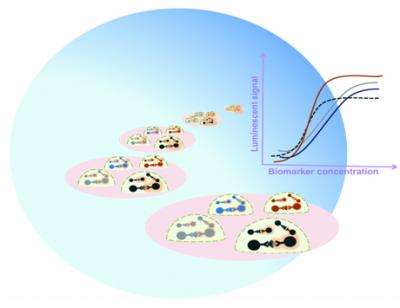Multiphase polymer systems are used to confine unique antibody-conjugated beads that bind with high sensitivity and specificity to plasma protein biomarkers, eliciting amplified luminescent signals. The signal intensity from the beads is proportional to the levels of disease biomarkers in the blood plasma. If protein levels exceed the clinical threshold, the patients are identified as having the disease. Credit: Technology
A new protein biomarker test platform developed by researchers at the University of Michigan and Indiana University promises to improve diagnostic testing. The test can accurately and simultaneously measure multiple proteins that indicate the presence of diseases like graft-versus-host disease (bone marrow transplant rejection) in only two hours, no washing steps, and using only a minute volume of blood plasma. A report on this new technology can be found online in the journal Technology.
The protein test uses a micropatterning method developed in Shuichi Takayama's Micro/Nano/Molecular Biotechnology Lab. "Just as oil and water remain immiscible, we use two aqueous solutions that do not mix with each other," said Dr. Takayama, Professor of Biomedical Engineering and Macromolecular Science and Engineering. "Interestingly, these solutions can be patterned into arrays, whereas standard no-wash protein test reagents normally just mix together in solution. This novel capability makes it possible, for the first time, to measure multiple diagnostic proteins at a time in a no-wash format test."
To perform the assay, a few microliters of blood plasma is mixed with poly(ethylene glycol) and added to a microwell in a custom 384-well microplate. Next, microdroplets of dextran, containing complimentary pairs of antibody-beads, are dispensed into microbasins within the sample well. During a two-hour incubation, target plasma protein biomarkers diffuse from the poly(ethylene glycol) phase to the dextran droplets and become sandwiched by the antibody beads. The microplate is then read on a commercially available plate reader.
The team demonstrated the effectiveness of their bioassay by measuring protein biomarkers from cytokine-stimulated cells, as well as from the plasma of bone marrow transplant patients. Detecting levels of proinflammatory cytokines and chemokines in blood plasma can be crucial in the diagnosis of graft-versus-host disease (GVHD) - the leading cause of death among allogeneic bone marrow transplant patients.
"We envision that our user-friendly and highly accurate platform will be widely used by academic and clinical researchers for diagnostics as well as other applications," said Arlyne Simon, Ph.D., the lead author on this publication. "To ease the adoption of our technology into research and clinical labs, we designed custom microplates that can be analyzed by commercially available plate readers."
More information: Arlyne B. Simon et al, Technology 02, 176 (2014). DOI: 10.1142/S2339547814500150
Provided by World Scientific Publishing




















